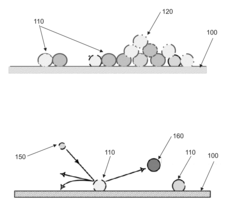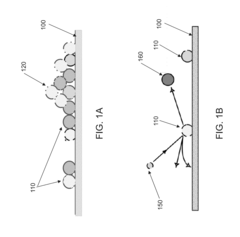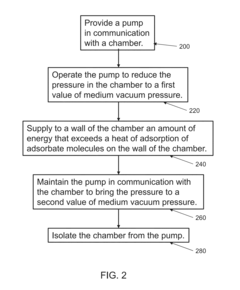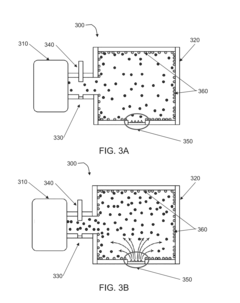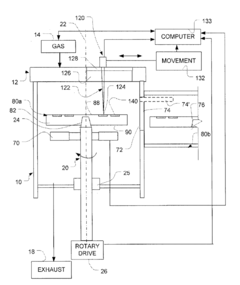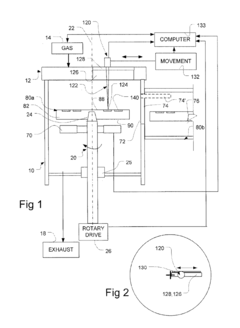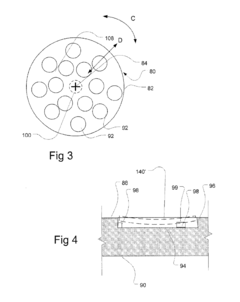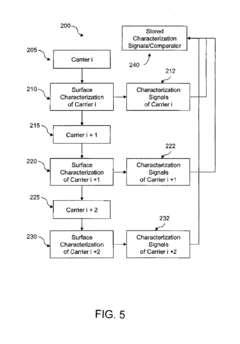How Vacuum Pumps Support Advanced Surface Characterization Methods
JUL 21, 20259 MIN READ
Generate Your Research Report Instantly with AI Agent
Patsnap Eureka helps you evaluate technical feasibility & market potential.
Vacuum Pump Evolution and Objectives
Vacuum pumps have played a crucial role in the evolution of surface characterization methods, enabling researchers to study materials at the atomic and molecular levels. The development of vacuum technology has been closely intertwined with advancements in surface science, driving innovation in both fields.
The journey of vacuum pumps began in the 17th century with the invention of the first mechanical vacuum pump by Otto von Guericke. However, it wasn't until the late 19th and early 20th centuries that vacuum technology started to significantly impact scientific research. The introduction of oil-sealed rotary vane pumps in the 1920s marked a significant milestone, providing a reliable means of achieving medium vacuum levels.
As surface characterization techniques became more sophisticated, the demand for higher vacuum levels increased. This led to the development of diffusion pumps in the 1930s, capable of achieving high vacuum conditions. The advent of ultra-high vacuum (UHV) systems in the 1950s and 1960s revolutionized surface science, allowing for the study of clean surfaces without contamination from residual gases.
The objectives of vacuum pump technology in supporting advanced surface characterization methods have evolved over time. Initially, the primary goal was to achieve lower pressures to minimize interference from atmospheric gases. As techniques like X-ray photoelectron spectroscopy (XPS) and scanning tunneling microscopy (STM) emerged, the focus shifted to maintaining stable vacuum conditions over extended periods.
Today, the objectives of vacuum pump technology in surface characterization include achieving ultra-low pressures (below 10^-10 mbar), minimizing vibration and noise, reducing pump-induced contamination, and improving energy efficiency. These goals are driven by the increasing precision and sensitivity of surface analysis techniques, which require pristine sample environments.
The trend towards in-situ and operando studies has also influenced vacuum pump objectives. Modern systems aim to provide dynamic vacuum control, allowing researchers to study surfaces under varying pressure conditions or in the presence of specific gases. This capability is crucial for understanding surface reactions and material behavior in real-world applications.
Looking forward, the objectives of vacuum pump technology in surface characterization are likely to focus on further miniaturization, integration with advanced control systems, and compatibility with emerging analytical techniques. As nanotechnology and quantum-based characterization methods continue to advance, vacuum pumps will need to meet even more stringent requirements for pressure stability, cleanliness, and operational flexibility.
The journey of vacuum pumps began in the 17th century with the invention of the first mechanical vacuum pump by Otto von Guericke. However, it wasn't until the late 19th and early 20th centuries that vacuum technology started to significantly impact scientific research. The introduction of oil-sealed rotary vane pumps in the 1920s marked a significant milestone, providing a reliable means of achieving medium vacuum levels.
As surface characterization techniques became more sophisticated, the demand for higher vacuum levels increased. This led to the development of diffusion pumps in the 1930s, capable of achieving high vacuum conditions. The advent of ultra-high vacuum (UHV) systems in the 1950s and 1960s revolutionized surface science, allowing for the study of clean surfaces without contamination from residual gases.
The objectives of vacuum pump technology in supporting advanced surface characterization methods have evolved over time. Initially, the primary goal was to achieve lower pressures to minimize interference from atmospheric gases. As techniques like X-ray photoelectron spectroscopy (XPS) and scanning tunneling microscopy (STM) emerged, the focus shifted to maintaining stable vacuum conditions over extended periods.
Today, the objectives of vacuum pump technology in surface characterization include achieving ultra-low pressures (below 10^-10 mbar), minimizing vibration and noise, reducing pump-induced contamination, and improving energy efficiency. These goals are driven by the increasing precision and sensitivity of surface analysis techniques, which require pristine sample environments.
The trend towards in-situ and operando studies has also influenced vacuum pump objectives. Modern systems aim to provide dynamic vacuum control, allowing researchers to study surfaces under varying pressure conditions or in the presence of specific gases. This capability is crucial for understanding surface reactions and material behavior in real-world applications.
Looking forward, the objectives of vacuum pump technology in surface characterization are likely to focus on further miniaturization, integration with advanced control systems, and compatibility with emerging analytical techniques. As nanotechnology and quantum-based characterization methods continue to advance, vacuum pumps will need to meet even more stringent requirements for pressure stability, cleanliness, and operational flexibility.
Surface Characterization Market Analysis
The surface characterization market has experienced significant growth in recent years, driven by advancements in nanotechnology, materials science, and semiconductor industries. This market encompasses a wide range of analytical techniques and instruments used to study the physical and chemical properties of surfaces at the micro and nanoscale levels.
The global surface characterization market was valued at approximately $3.5 billion in 2020 and is projected to reach $5.8 billion by 2026, growing at a CAGR of 8.7% during the forecast period. This growth is primarily attributed to the increasing demand for high-performance materials in various industries, including electronics, automotive, aerospace, and healthcare.
One of the key factors driving market growth is the rising adoption of surface characterization techniques in the semiconductor industry. As chip manufacturers continue to push the boundaries of miniaturization and performance, the need for precise surface analysis becomes crucial. This has led to increased investments in advanced surface characterization tools, such as atomic force microscopy (AFM) and X-ray photoelectron spectroscopy (XPS).
The healthcare and life sciences sectors are also emerging as significant contributors to market growth. Surface characterization techniques are increasingly being used in drug development, biomaterials research, and medical device manufacturing. This trend is expected to continue as the importance of surface properties in biocompatibility and drug delivery becomes more apparent.
Geographically, North America and Europe currently dominate the surface characterization market, accounting for over 60% of the global market share. However, the Asia-Pacific region is expected to witness the highest growth rate in the coming years, driven by rapid industrialization, increasing R&D investments, and growing adoption of advanced technologies in countries like China, Japan, and South Korea.
The market is characterized by the presence of several key players, including Bruker Corporation, HORIBA Ltd., JEOL Ltd., and Thermo Fisher Scientific Inc. These companies are focusing on product innovation and strategic partnerships to maintain their competitive edge in the market. For instance, recent advancements in automation and artificial intelligence have led to the development of more user-friendly and efficient surface characterization instruments.
Despite the positive outlook, the surface characterization market faces challenges such as high instrument costs and the need for skilled operators. These factors may hinder market growth, particularly in emerging economies. However, the increasing focus on research and development activities across various industries is expected to create new opportunities for market expansion in the coming years.
The global surface characterization market was valued at approximately $3.5 billion in 2020 and is projected to reach $5.8 billion by 2026, growing at a CAGR of 8.7% during the forecast period. This growth is primarily attributed to the increasing demand for high-performance materials in various industries, including electronics, automotive, aerospace, and healthcare.
One of the key factors driving market growth is the rising adoption of surface characterization techniques in the semiconductor industry. As chip manufacturers continue to push the boundaries of miniaturization and performance, the need for precise surface analysis becomes crucial. This has led to increased investments in advanced surface characterization tools, such as atomic force microscopy (AFM) and X-ray photoelectron spectroscopy (XPS).
The healthcare and life sciences sectors are also emerging as significant contributors to market growth. Surface characterization techniques are increasingly being used in drug development, biomaterials research, and medical device manufacturing. This trend is expected to continue as the importance of surface properties in biocompatibility and drug delivery becomes more apparent.
Geographically, North America and Europe currently dominate the surface characterization market, accounting for over 60% of the global market share. However, the Asia-Pacific region is expected to witness the highest growth rate in the coming years, driven by rapid industrialization, increasing R&D investments, and growing adoption of advanced technologies in countries like China, Japan, and South Korea.
The market is characterized by the presence of several key players, including Bruker Corporation, HORIBA Ltd., JEOL Ltd., and Thermo Fisher Scientific Inc. These companies are focusing on product innovation and strategic partnerships to maintain their competitive edge in the market. For instance, recent advancements in automation and artificial intelligence have led to the development of more user-friendly and efficient surface characterization instruments.
Despite the positive outlook, the surface characterization market faces challenges such as high instrument costs and the need for skilled operators. These factors may hinder market growth, particularly in emerging economies. However, the increasing focus on research and development activities across various industries is expected to create new opportunities for market expansion in the coming years.
Vacuum Technology Challenges
Vacuum technology plays a crucial role in advanced surface characterization methods, yet it faces several significant challenges. One of the primary issues is achieving and maintaining ultra-high vacuum (UHV) conditions, which are essential for many surface analysis techniques. UHV environments, typically defined as pressures below 10^-9 mbar, are notoriously difficult to create and sustain due to outgassing from chamber materials and samples.
The design and construction of vacuum chambers present another set of challenges. Materials used must have low outgassing rates and be compatible with UHV conditions. This often necessitates the use of specialized alloys and surface treatments, which can significantly increase costs and complexity. Additionally, the need for various ports and feedthroughs for instruments and sample manipulation introduces potential leak points, further complicating chamber design.
Pump selection and integration pose their own set of difficulties. Different types of vacuum pumps, such as turbomolecular, ion, and cryogenic pumps, each have their strengths and limitations. Choosing the right combination of pumps to achieve the desired vacuum level while minimizing contamination and vibration is a delicate balancing act. Furthermore, the pumps themselves can introduce contaminants or cause sample disturbance, potentially compromising measurement accuracy.
Contamination control remains an ongoing challenge in vacuum technology. Even minute amounts of contaminants can significantly affect surface measurements. Sources of contamination include residual gases, pump oils, and materials used in the vacuum system itself. Developing effective cleaning protocols and implementing contamination mitigation strategies are critical aspects of vacuum technology that require continuous improvement.
The increasing demand for in-situ and operando measurements adds another layer of complexity to vacuum technology challenges. These techniques often require the introduction of reactive gases or liquids into the vacuum chamber, which can compromise vacuum integrity and potentially damage sensitive equipment. Designing systems that can maintain UHV conditions while allowing for controlled introduction of reactive species is a significant engineering challenge.
Lastly, the miniaturization trend in surface characterization instruments presents unique vacuum technology challenges. As instruments become smaller and more portable, there is a growing need for compact, efficient vacuum systems that can achieve high performance in confined spaces. This drives innovation in pump design and vacuum chamber engineering but also introduces new obstacles in thermal management and vibration isolation.
The design and construction of vacuum chambers present another set of challenges. Materials used must have low outgassing rates and be compatible with UHV conditions. This often necessitates the use of specialized alloys and surface treatments, which can significantly increase costs and complexity. Additionally, the need for various ports and feedthroughs for instruments and sample manipulation introduces potential leak points, further complicating chamber design.
Pump selection and integration pose their own set of difficulties. Different types of vacuum pumps, such as turbomolecular, ion, and cryogenic pumps, each have their strengths and limitations. Choosing the right combination of pumps to achieve the desired vacuum level while minimizing contamination and vibration is a delicate balancing act. Furthermore, the pumps themselves can introduce contaminants or cause sample disturbance, potentially compromising measurement accuracy.
Contamination control remains an ongoing challenge in vacuum technology. Even minute amounts of contaminants can significantly affect surface measurements. Sources of contamination include residual gases, pump oils, and materials used in the vacuum system itself. Developing effective cleaning protocols and implementing contamination mitigation strategies are critical aspects of vacuum technology that require continuous improvement.
The increasing demand for in-situ and operando measurements adds another layer of complexity to vacuum technology challenges. These techniques often require the introduction of reactive gases or liquids into the vacuum chamber, which can compromise vacuum integrity and potentially damage sensitive equipment. Designing systems that can maintain UHV conditions while allowing for controlled introduction of reactive species is a significant engineering challenge.
Lastly, the miniaturization trend in surface characterization instruments presents unique vacuum technology challenges. As instruments become smaller and more portable, there is a growing need for compact, efficient vacuum systems that can achieve high performance in confined spaces. This drives innovation in pump design and vacuum chamber engineering but also introduces new obstacles in thermal management and vibration isolation.
Current Vacuum Solutions
01 Rotary vacuum pump designs
Various rotary vacuum pump designs have been developed to improve efficiency and performance. These include innovations in rotor configurations, sealing mechanisms, and chamber designs to enhance suction power and reduce friction. Some designs focus on compact arrangements for specific applications, while others aim to optimize flow characteristics and minimize wear.- Improvements in vacuum pump design: Various advancements in vacuum pump design have been made to enhance efficiency and performance. These improvements may include modifications to pump components, innovative sealing mechanisms, and optimized fluid flow paths. Such enhancements can lead to increased pumping speed, better vacuum levels, and improved overall reliability.
- Specialized vacuum pumps for semiconductor manufacturing: Vacuum pumps tailored for semiconductor manufacturing processes have been developed to meet the stringent requirements of the industry. These pumps often feature contamination control measures, high pumping speeds, and compatibility with corrosive gases. They play a crucial role in various semiconductor fabrication steps, including etching, deposition, and ion implantation.
- Historical developments in vacuum pump technology: The evolution of vacuum pump technology spans several decades, with numerous innovations contributing to improved performance and functionality. Early designs focused on mechanical pumping mechanisms, while later developments incorporated advanced materials, precision engineering, and electronic controls to enhance pump capabilities and reliability.
- Integration of vacuum pumps in automotive systems: Vacuum pumps have found applications in various automotive systems, including brake boosters, engine management, and emissions control. These pumps are designed to operate efficiently within the constraints of vehicle environments, providing the necessary vacuum for specific automotive functions while minimizing energy consumption and noise.
- Vacuum pump control and monitoring systems: Advanced control and monitoring systems have been developed to optimize vacuum pump operation and maintenance. These systems may include sensors for real-time performance monitoring, intelligent control algorithms for energy efficiency, and predictive maintenance capabilities. Such features help improve pump longevity, reduce downtime, and enhance overall system reliability.
02 Vacuum pump control systems
Advanced control systems for vacuum pumps have been implemented to optimize operation and energy efficiency. These systems may include sensors, electronic controllers, and variable speed drives to adjust pump performance based on demand. Some designs incorporate intelligent algorithms for predictive maintenance and automatic adjustment of operating parameters.Expand Specific Solutions03 Specialized vacuum pumps for semiconductor manufacturing
Vacuum pumps tailored for semiconductor manufacturing processes have been developed to meet the stringent requirements of clean room environments. These pumps often feature corrosion-resistant materials, contamination control mechanisms, and high pumping speeds for specific gases used in semiconductor fabrication.Expand Specific Solutions04 Multi-stage vacuum pump systems
Multi-stage vacuum pump systems have been designed to achieve higher vacuum levels and improved pumping efficiency. These systems typically combine different pump types or multiple pumping stages to progressively reduce pressure. Some designs focus on optimizing the interaction between stages and minimizing backflow.Expand Specific Solutions05 Vacuum pump sealing and lubrication innovations
Advancements in sealing and lubrication technologies for vacuum pumps have been made to enhance performance and longevity. These innovations include improved seal designs, novel lubricant formulations, and self-lubricating materials. Some designs aim to reduce friction, minimize contamination, and extend maintenance intervals.Expand Specific Solutions
Key Vacuum Pump Manufacturers
The vacuum pump industry supporting advanced surface characterization methods is in a mature stage, with a global market size estimated to be in the billions of dollars. The technology has reached a high level of sophistication, with key players like Edwards Ltd., LEYBOLD AG, and Pfeiffer Vacuum SAS leading innovation. Research institutions such as Korea Research Institute of Standards & Science and Centre National de la Recherche Scientifique collaborate with industry to push technological boundaries. Major semiconductor and electronics manufacturers like Samsung Electronics and Micron Technology drive demand for increasingly precise and efficient vacuum solutions. The market is characterized by ongoing refinements in pump design, materials, and control systems to meet the evolving needs of surface analysis techniques.
Edwards Ltd.
Technical Solution: Edwards Ltd. has developed advanced vacuum pump technologies specifically tailored for surface characterization methods. Their innovative dry pumps, such as the nXDS scroll pump series, provide oil-free, clean vacuum environments essential for sensitive surface analysis techniques[1]. These pumps utilize advanced scroll technology to achieve high pumping speeds while maintaining low ultimate pressures, typically reaching 10^-2 mbar or lower[2]. Edwards has also introduced intelligent pump control systems that optimize performance and energy efficiency during surface characterization processes. Their pumps are designed to minimize vibration and acoustic noise, crucial for maintaining the stability and accuracy of surface analysis instruments[3].
Strengths: Oil-free operation, high pumping speeds, low ultimate pressures, and intelligent control systems. Weaknesses: Higher initial cost compared to traditional oil-sealed pumps, potential for more complex maintenance.
Hitachi High-Tech America, Inc.
Technical Solution: Hitachi High-Tech America has developed specialized vacuum systems integrated into their surface analysis instruments, particularly for scanning electron microscopy (SEM) and transmission electron microscopy (TEM). Their vacuum solutions incorporate turbomolecular pumps and ion pumps to achieve the ultra-high vacuum conditions necessary for high-resolution surface imaging and analysis[1]. Hitachi's systems often employ differential pumping techniques, allowing for variable pressure modes in SEM, which enables the examination of non-conductive or biological samples[2]. They have also developed advanced electron gun designs that require extremely high vacuum levels, often reaching 10^-10 Pa or better. Hitachi's vacuum systems are known for their stability and low vibration characteristics, crucial for maintaining high-resolution imaging capabilities in surface characterization[3].
Strengths: Highly integrated vacuum systems for specific electron microscopy applications, advanced differential pumping capabilities, and stable, low-vibration performance. Weaknesses: Highly specialized systems may have limited applicability outside of Hitachi's instruments, potentially higher costs due to integration with specific analytical tools.
Innovative Vacuum Pump Designs
Surface adsorption vacuum pumps and methods for producing adsorbate-free surfaces
PatentInactiveUS20150221487A9
Innovation
- A method and apparatus for generating adsorbate-free surfaces using energy sources like ion bombardment, electron bombardment, or heating to reduce pressure in chambers to ultra-high vacuum levels, allowing for the creation of miniaturized low-power vacuum pumps that maintain low pressures without additional evacuation.
Heated wafer carrier profiling
PatentInactiveUS20120304926A1
Innovation
- A system comprising a rotatable wafer carrier with a surface characterization tool that moves over the wafers to collect position-dependent data on temperature, reflectance, photoluminescence, and emissivity, which is used to adjust heating and gas sources in real-time, ensuring uniform conditions and optimizing the deposition process.
Vacuum Standards and Regulations
Vacuum standards and regulations play a crucial role in ensuring the reliability, safety, and performance of vacuum systems used in advanced surface characterization methods. These standards provide guidelines for the design, operation, and maintenance of vacuum equipment, including vacuum pumps, which are essential components in creating and maintaining the ultra-high vacuum environments required for precise surface analysis.
International organizations, such as the International Organization for Standardization (ISO) and the American Vacuum Society (AVS), have developed comprehensive standards for vacuum technology. These standards cover various aspects, including vacuum measurement, leak detection, and pump performance evaluation. For instance, ISO 21360 series focuses on standard methods for measuring and specifying the characteristics of vacuum pumps, ensuring consistency in performance evaluation across different manufacturers and applications.
Regulatory bodies, such as the European Union's Machinery Directive and the United States Occupational Safety and Health Administration (OSHA), have established safety regulations for vacuum equipment. These regulations address potential hazards associated with vacuum systems, including implosion risks, electrical safety, and exposure to harmful substances. Compliance with these regulations is essential for manufacturers and users of vacuum pumps in surface characterization laboratories.
Vacuum standards also define the classification of vacuum levels, which is crucial for selecting appropriate pumps and equipment for specific surface characterization techniques. The ISO 3529 standard, for example, defines vacuum ranges from low to ultra-high vacuum, providing a common language for researchers and engineers working with vacuum systems in surface analysis.
Furthermore, standards related to cleanliness and contamination control in vacuum systems are particularly relevant to surface characterization methods. ISO 14644 standards for cleanrooms and associated controlled environments provide guidelines for maintaining the purity of vacuum environments, which is critical for accurate surface analysis results.
As surface characterization techniques continue to advance, vacuum standards and regulations are evolving to address new challenges and requirements. For instance, emerging standards focus on energy efficiency and environmental impact of vacuum pumps, aligning with global sustainability goals. Additionally, standards for vacuum system integration and automation are being developed to support the increasing complexity of surface analysis instrumentation.
Adherence to these standards and regulations not only ensures the quality and reliability of surface characterization results but also promotes safety and consistency across research and industrial applications. As vacuum pump technology continues to evolve, ongoing collaboration between industry stakeholders, regulatory bodies, and standards organizations is essential to keep pace with technological advancements and maintain the highest levels of performance and safety in surface characterization methods.
International organizations, such as the International Organization for Standardization (ISO) and the American Vacuum Society (AVS), have developed comprehensive standards for vacuum technology. These standards cover various aspects, including vacuum measurement, leak detection, and pump performance evaluation. For instance, ISO 21360 series focuses on standard methods for measuring and specifying the characteristics of vacuum pumps, ensuring consistency in performance evaluation across different manufacturers and applications.
Regulatory bodies, such as the European Union's Machinery Directive and the United States Occupational Safety and Health Administration (OSHA), have established safety regulations for vacuum equipment. These regulations address potential hazards associated with vacuum systems, including implosion risks, electrical safety, and exposure to harmful substances. Compliance with these regulations is essential for manufacturers and users of vacuum pumps in surface characterization laboratories.
Vacuum standards also define the classification of vacuum levels, which is crucial for selecting appropriate pumps and equipment for specific surface characterization techniques. The ISO 3529 standard, for example, defines vacuum ranges from low to ultra-high vacuum, providing a common language for researchers and engineers working with vacuum systems in surface analysis.
Furthermore, standards related to cleanliness and contamination control in vacuum systems are particularly relevant to surface characterization methods. ISO 14644 standards for cleanrooms and associated controlled environments provide guidelines for maintaining the purity of vacuum environments, which is critical for accurate surface analysis results.
As surface characterization techniques continue to advance, vacuum standards and regulations are evolving to address new challenges and requirements. For instance, emerging standards focus on energy efficiency and environmental impact of vacuum pumps, aligning with global sustainability goals. Additionally, standards for vacuum system integration and automation are being developed to support the increasing complexity of surface analysis instrumentation.
Adherence to these standards and regulations not only ensures the quality and reliability of surface characterization results but also promotes safety and consistency across research and industrial applications. As vacuum pump technology continues to evolve, ongoing collaboration between industry stakeholders, regulatory bodies, and standards organizations is essential to keep pace with technological advancements and maintain the highest levels of performance and safety in surface characterization methods.
Environmental Impact of Vacuum Systems
Vacuum systems, while essential for advanced surface characterization methods, have significant environmental implications that warrant careful consideration. The primary environmental concern associated with vacuum pumps is their energy consumption. These systems often require continuous operation to maintain the necessary vacuum levels, resulting in substantial electricity usage. This energy demand contributes to increased carbon emissions, particularly in regions where electricity generation relies heavily on fossil fuels.
Furthermore, the production and disposal of vacuum pump components raise environmental issues. Many pumps contain materials that are difficult to recycle or dispose of safely, such as certain metals and lubricants. The manufacturing process of these components also involves resource extraction and energy-intensive production methods, adding to the overall environmental footprint of vacuum systems.
Noise pollution is another environmental factor to consider. Some vacuum pumps, especially older models or those used in industrial settings, can generate significant noise levels. This can impact both the immediate work environment and surrounding areas, potentially affecting wildlife and human communities.
The use of working fluids in certain types of vacuum pumps presents additional environmental challenges. Some pumps employ oils or other substances that can potentially leak or require periodic replacement. The disposal of these fluids must be managed carefully to prevent soil and water contamination.
However, it's important to note that the vacuum industry is actively working to address these environmental concerns. Manufacturers are developing more energy-efficient pump designs, incorporating variable speed drives and improved motor technologies to reduce power consumption. There's also a growing trend towards the use of dry pumps, which eliminate the need for oil and reduce the risk of contamination.
Efforts are being made to improve the recyclability and longevity of vacuum system components. This includes the use of more sustainable materials and modular designs that facilitate easier repair and component replacement, extending the lifespan of the equipment and reducing waste.
In the context of surface characterization, the environmental impact of vacuum systems must be weighed against the scientific and technological advancements they enable. These systems are crucial for developing new materials and technologies that may have significant environmental benefits, such as more efficient solar cells or advanced catalysts for cleaner industrial processes.
Furthermore, the production and disposal of vacuum pump components raise environmental issues. Many pumps contain materials that are difficult to recycle or dispose of safely, such as certain metals and lubricants. The manufacturing process of these components also involves resource extraction and energy-intensive production methods, adding to the overall environmental footprint of vacuum systems.
Noise pollution is another environmental factor to consider. Some vacuum pumps, especially older models or those used in industrial settings, can generate significant noise levels. This can impact both the immediate work environment and surrounding areas, potentially affecting wildlife and human communities.
The use of working fluids in certain types of vacuum pumps presents additional environmental challenges. Some pumps employ oils or other substances that can potentially leak or require periodic replacement. The disposal of these fluids must be managed carefully to prevent soil and water contamination.
However, it's important to note that the vacuum industry is actively working to address these environmental concerns. Manufacturers are developing more energy-efficient pump designs, incorporating variable speed drives and improved motor technologies to reduce power consumption. There's also a growing trend towards the use of dry pumps, which eliminate the need for oil and reduce the risk of contamination.
Efforts are being made to improve the recyclability and longevity of vacuum system components. This includes the use of more sustainable materials and modular designs that facilitate easier repair and component replacement, extending the lifespan of the equipment and reducing waste.
In the context of surface characterization, the environmental impact of vacuum systems must be weighed against the scientific and technological advancements they enable. These systems are crucial for developing new materials and technologies that may have significant environmental benefits, such as more efficient solar cells or advanced catalysts for cleaner industrial processes.
Unlock deeper insights with Patsnap Eureka Quick Research — get a full tech report to explore trends and direct your research. Try now!
Generate Your Research Report Instantly with AI Agent
Supercharge your innovation with Patsnap Eureka AI Agent Platform!
